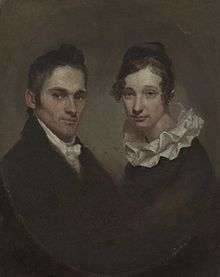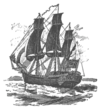Hiram Bingham I
Hiram Bingham, formally Hiram Bingham I (October 30, 1789 – November 11, 1869), was leader of the first group of American Protestant missionaries to introduce Christianity to the Hawaiian islands. Like most of the missionaries, he was from New England.
Hiram Bingham I | |
|---|---|
 Missionary to Hawaii | |
| Born | October 30, 1789 Bennington, Vermont, USA |
| Died | November 11, 1869 (aged 80) New Haven, Connecticut, USA |
| Alma mater | Middlebury College |
| Occupation | Missionary, writer, translator, royal advisor |
| Known for | converting the Kingdom of Hawaii to Christianity and serving as Kawaiahaʻo Church's first pastor |
| Spouse(s) | Sybil Moseley Naomi E. Morse |
| Children | Hiram Bingham II, and six other |
| Parent(s) | Calvin and Lydia Bingham |
| Signature | |
 | |

Life
Bingham was descended from Deacon Thomas Bingham, who immigrated to the American colonies in 1650 and settled in Connecticut. He was born October 30, 1789, in Bennington, Vermont, one of thirteen children of his mother Lydia and father Calvin Bingham.[1] He attended Middlebury College and the Andover Theological Seminary.[2]
After breaking his first engagement, Bingham found a new bride, Sybil Moseley. He needed to be married to be accepted as a missionary. On October 23, 1819, the young couple sailed out of Boston aboard the brig Thaddeus, along with Asa and Lucy Goodale Thurston, to lead a mission in the Sandwich Islands (Hawaii) for the American Board of Commissioners for Foreign Missions.[3]
Hawaii
Bingham and his wife arrived first on the Island of Hawaii in 1820, and sailed on to Honolulu on Oahu on April 19. In 1823, Queen Kaʻahumanu and six high chiefs requested baptism. Soon after, the Hawaiian government banned prostitution and drunkenness, which resulted in the shipping industry and the foreign community resenting Bingham's influence.[4] Bingham wrote extensively about the natives and was critical of their land-holding regime and of their "state of civilization". Bingham supported the introduction of market values along with Christianity. Those writings are now used by historians to illustrate the imperial values that were central to the attitudes of the United States towards Hawaii.[5] Bingham was involved in the creation of the spelling system for writing the Hawaiian Language, and also translated some books of the Bible into Hawaiian.[6]
Bingham designed the Kawaiahaʻo Church in Honolulu on the Hawaiian Island of Oʻahu. The church was constructed between 1836 and 1842 in the New England style typical of the Hawaiian missionaries. It is one of the oldest standing Christian places of worship in Hawaiʻi.
Bingham used his influence with Queen Kaʻahumanu to instigate a strongly anti-Catholic policy in Hawaii, considerably impeding the work of the French Catholic missionary Alexis Bachelot and resulting in decades of persecution of Hawaiians who were converted to Catholicism. This was motivated by opposition to the spread of French influence in Hawaii as well as by the religious Protestant-Catholic rivalry and enmity.
Legacy and honors
- A math building in Punahou School is named after Bingham.
- Bingham Tract School was an academically rigorous elementary school named for him that operated on the Bingham lands until the mid-1990s.
Return
The board grew concerned that Bingham was interfering too often in Hawaiian politics and recalled him. The Binghams left August 3, 1840 and reached New England February 4, 1841.[7] It was intended to be a sabbatical due to Sybil's poor health, but the board refused to reappoint Bingham as a missionary, even after Sybil's death on February 27, 1848. He published a memoir, A Residence of Twenty-One Years in the Sandwich Islands in 1847.[8]
Bingham remained in New England, where he served as the pastor of an African-American church. He remarried to Naomi Morse in 1852, who ran a girls' school. He died November 11, 1869 and was buried at Grove Street Cemetery, in New Haven, Connecticut. Leonard Bacon gave the address at his funeral.[1]
Hawaiian Bible and hymns
Bingham was the leader of a group of missionaries, that included Asa Thurston, Artemas Bishop and himself, who translated the Christian Bible into the Hawaiian language. The New Testament was published in 1832, and the Old Testament in 1839. The entire NT/OT Bible was revised in 1868, and was re-published as Ka Baibola Hemolele (The Holy Bible) in 2018, in the forms of book and electronic document.[9].
Binamu (Bingham's Hawaiian name) also composed Hawaiian hymns,[10] such as "Himeni Hope" (closing hymn), starting with "Ho'omaika'i i ka Makua Ke Akua o kakou, ...", meaning "Blessings to the Father, the God of us all, ..."), which were typically quiet, reflexive, but powerful. His hymns are still sung in Hawaii at the churches and by the choruses in concert.
Legacy
Bingham's son, Hiram Bingham II, was also a missionary to the Kingdom of Hawaiʻi. His daughter Lydia married the later Hawaiian missionary Titus Coan.
His grandson Hiram Bingham III was an explorer who brought Machu Picchu to the attention of the west and became a US Senator and Governor of Connecticut.
His great-grandson Hiram Bingham IV was the US Vice Consul in Marseilles, France, during World War II who rescued Jews from the Holocaust. Another great-grandson, Jonathan Brewster Bingham, was a long-time Reform Democratic Congressman from The Bronx from the mid-1960s through the early 1980s.
In World War II, the United States liberty ship SS Hiram Bingham was named in his honor. It was hull number 1726.
Bingham was caricatured as the character Reverend Abner Hale in James Michener's novel Hawaii.[6]
See also
References
- "Congregational Necrology". The Congregational quarterly. Volume 13. American Congregational Association. pp. 593–596.
- Sarah Johnson and Eileen Moffett (Spring 2006). "Lord, Send Us: A Kaleidoscope of evangelists". Christian History & Biography. 90: 37–38.
- Lucy Goodale Thurston (1872). Life and Times of Mrs. Lucy G. Thurston: Wife of Rev. Asa Thurston, Pioneer Missionary to the Sandwich Islands. reprinted by Kessinger Publishing, LLC, 2007. ISBN 978-1-4325-4547-5.
- Fortune, Kate. 2000. Hiram Bingham. The Pacific Islands: An Encyclopedia, ed. by Brij V. Lala and Kate Fortune, p. 188. University of Hawai'i Press
- Alfred L. Brophy, How Missionaries Thought: About Property Law, For Instance, Hawaii Law Review (2008) 30: 373-99.
- David Stowe (1999). "Bingham, Hiram". In Gerald H. Anderson (ed.). Biographical Dictionary of Christian Missions. William B. Eerdmans Publishing. pp. 63–64. ISBN 978-0-8028-4680-8.
- Hawaiian Mission Children's Society (1901). Portraits of American Protestant missionaries to Hawaii. Honolulu: Hawaiian gazette co. p. 2.
- Hiram Bingham I (1855) [1848]. A Residence of Twenty-one Years in the Sandwich Islands (Third ed.). H.D. Goodwin.
- "No ka Baibala Hemolele: The Making of the Hawaiian Bible1 (Jeffrey Lyon, 2018), p. 124" (PDF). Hawaii.edu. Retrieved April 8, 2019.
- "Hiram Bingham - Hymnary.org". Hymnary.org. Retrieved April 8, 2019.
Further reading
- Hiram Bingham I (1988). Char Miller (ed.). Selected writings of Hiram Bingham, Missionary to the Hawaiian Islands: To Raise the Lord's Banner. E. Mellen Press, Lewiston, NY. ISBN 978-0-88946-675-3.
- Char Miller (1982). Fathers and sons, the Bingham family and the American mission. Temple University Press. ISBN 978-0-87722-248-4.
External links
| Wikimedia Commons has media related to Hiram Bingham (missionary born 1789). |
- Darlene E. Kelley (November 19, 2000). "Queen Kaahumanu — Part 2: First Arrival of Missionaries". Keepers of the Culture. U.S. GenWeb Archives web site. Archived from the original on July 19, 2011. Retrieved 2010-02-20.
- Hiram Bingham at Find a Grave
